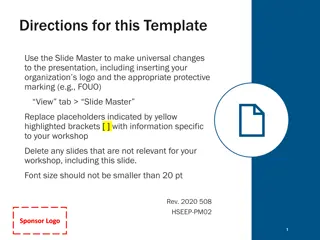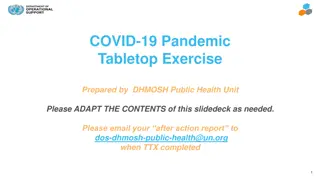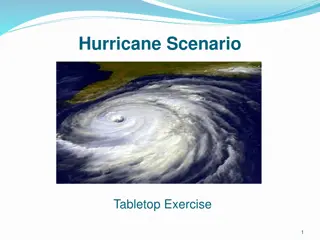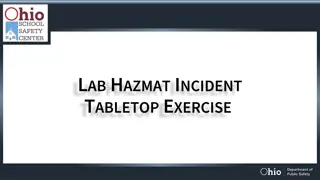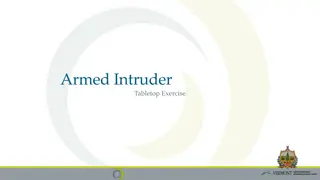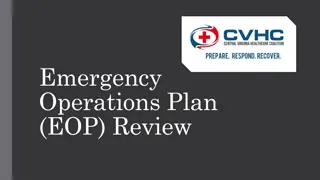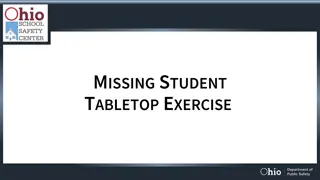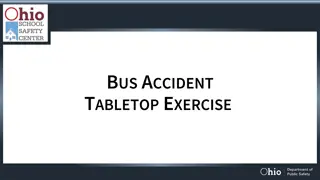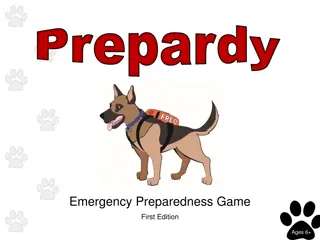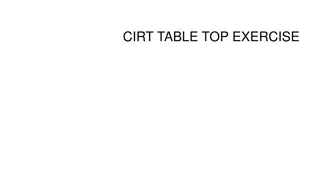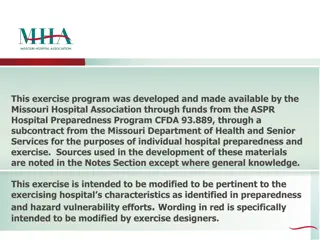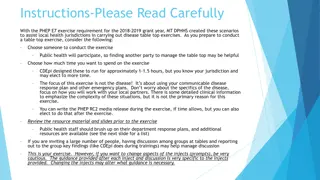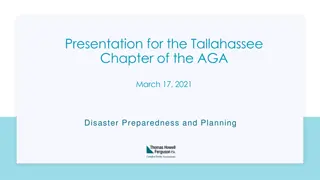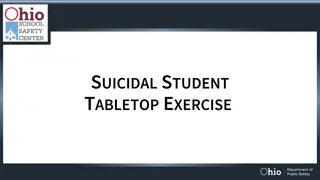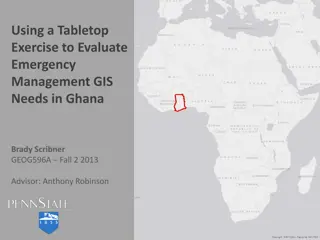Understanding Tabletop Exercises for Emergency Preparedness
Tabletop exercises are valuable tools for emergency preparedness, allowing teams to discuss and evaluate their responses to different scenarios in a controlled setting. These exercises help validate plans, assess systems needed, and identify areas for improvement in policies and procedures. Facilitators guide participants through discussions to enhance awareness and promote understanding of key concepts. The outcomes, like hot wash sessions and After Action Reports, focus on highlighting strengths and weaknesses for continual improvement.
Download Presentation

Please find below an Image/Link to download the presentation.
The content on the website is provided AS IS for your information and personal use only. It may not be sold, licensed, or shared on other websites without obtaining consent from the author. Download presentation by click this link. If you encounter any issues during the download, it is possible that the publisher has removed the file from their server.
E N D
Presentation Transcript
2020 Table Top Exercise The Violent/Agitated Patient Kentucky Kate Hill, RN
AGENDA Review information about tabletop exercise Tabletop Exercise Group discussion and decision Hot Wash Next Steps After Action report Corrective Action Plan
Tabletop Exercise Tabletop exercises are discussion-based sessions where team members meet in an informal, classroom setting to discuss their roles during an emergency and their responses to a particular emergency situation. A facilitator guides participants through a discussion of one or more scenarios. The duration of a tabletop exercise depends on the audience, the topic being exercised and the exercise objectives. Many tabletop exercises can be conducted in a few hours, so they are cost-effective tools to validate plans and capabilities.
Tabletops Tabletops can be used to: Enhance general awareness Validate plans and procedures Assess the types of systems needed to guide prevention of, protection from, response to, and recovery from a defined incident. Goal of Tabletops include Facilitating concept understanding Identifying strengths & weaknesses Achieving changes in attitudes.
Why do a Tabletop Testing the plan, not the people Key personnel discuss simulated scenarios in an informal setting Assist in the promotion of understanding related concepts Used to assess plans, policies, procedures or the systems employed by the organization Highlight strengths and areas for improvement within current plans, policies and procedures
Exercise Roles Facilitator Facilitates the exercise Participants (Players) Key Staff & Decision Makers External Agencies Elected / Appointed Officials Evaluators Observe behavior in relation to plans & procedures Record Information without leading Players Report observations Observers Observe exercise; No interaction in exercise play
Hot wash, AAR and CAP or POC Hot wash A debrief with the exercise planning team, controllers & evaluators held immediately following the exercise. Allows controllers and evaluators to collect observations and thoughts about the conduct of the exercise which leads to the development of preliminary analyses of exercise observations. After Action Report (AAR) Chronological narrative of discussion for each capability & associated activities Highlight both strengths and areas for improvement Identify discussion points relevant to your site s ability to carry out the activities Demonstrate the capabilities being exercised Corrective Action Plan (CAP) or Plan of Correction (PoC) Corrective actions are the concrete, actionable steps outlined in improvement plans that are intended to resolve preparedness gaps and shortcomings experienced in exercises or real world incidents.
Hot Wash What strengths in your workplace s emergency plans did this exercise identify? What weaknesses in your workplace s emergency plans did this exercise expose? What unanticipated issues arose during the exercise? What gaps were identified? What are some high-priority issues that should be addressed? What are some new ideas and recommendations for improvement?
Exercise: The Violent/Agitated Patient The front office / receptionist staff has been checking-in patients and performing customary duties. Patients are directed to the waiting room to be called by staff and be taken back to the exam area. A female patient in the waiting room begins to look agitated and starts saying out loud how ridiculous it is patients must be 15 minutes early, but doctors can be as late as they want. Patient then comes to the front desk to express their dissatisfaction with wait time and demands to be seen. Receptionist cannot calm her down. Staff hears the commotion
Exercise: The Violent Patient Discussion Who should be informed of this behavior? What concerns might you have? What actions would you consider taking, if any, at this stage?
Exercise: The Violent Patient Discussion Update: Patient attempts to go back to exam room area. What actions should you take? How are you communicating with employees? With patients? Who is communicating? Who is in charge of the situation? Who is responsible for contacting law enforcement? What information do you relay to them?
Exercise: The Violent/Agitated Patient Discussion Possible Actions: A seasoned staff member could bring the patient into the back Seat the patient and sit opposite him Do not block the door as she may feel trapped Verbally engage the patient Establish a collaborative relationship Verbally de-escalate the patient out of the agitated state Objectives: Ensure the safety of the patient, staff and others in the clinic Help the patient manage his emotions and distress and maintain or regain control of his behavior Avoid restraining Avoid coercive interventions that escalate agitation
Exercise: Calmly ask some questions What has been stressful lately? Who is your support system? How do you typically spend your days? How has eating and sleeping been going? Have you been isolating more lately? Any medication or medication changes and how is that impacting you? What are your goals one year from now? Any other questions feel free to get back to me.
Exercise: The Violent/Agitated Patient Discussion Remain Calm. When dealing with trying patients, the best approach is to remain calm. ... Engage in Conversation. Try to draw out the patient's feelings by engaging in conversation. ... Be Empathetic. One of the quickest ways to calm an angry or difficult patient is by being empathetic. ... Avoid Arguing. ...
Exercise: The Violent/Agitated Patient Discussion Update: Patient is yelling, slamming things around, and hitting the walls. Other patients in the waiting room are visibly frightened, some have gotten up and run out of the clinic, others are frozen/afraid to move, and one patient has gotten up to subdue the agitated patient. What action will you take to ensure the safety of the other patients and staff? Whois responsible for deciding what actions to take? What additional concerns do you have at this time? Are you able to communicate with employees? How?
Exercise: The Violent/Agitated Patient Discussion Update: Agitated patient has now become physically violent, hitting the other patient that came to help several times rendering him/ her bloody and unconscious. The agitated female patient has blood on her face and hands; blood has also gotten on the floor, walls, and doors. What are your immediate concerns at this time? What will you do about the patient laying unconscious on the floor bleeding? What actions are being taken, and who is doing what?
Exercise: The Violent Patient Discussion Update: Law enforcement personnel arrive on-site. The agitated female patient was uncooperative and was subdued by law enforcement using a taser. Paramedics arrive, and law enforcement accompany the female patient to the hospital. A separate ambulance arrives and takes the good Samaritan patient to the emergency room. How will you account for patients? Employees? How do you prepare your employees for the disturbing scenes they may encounter as they leave the building? Who is responsible for communicating with law enforcement? Who is responsible for communicating with news media What information will you give them? Can you control who else the media approaches? If not, what can you do?
Exercise: The Violent Patient Discussion Update: The building is designated a crime scene and will be closed for a minimum of two days for investigation and hazmat cleaning. Who initiates business continuity plans? What else needs to be considered? How is information disseminated to employees? To patients?
Exercise: The Violent Patient Discussion Update: Two Days Later... You are able to get back into the building and resume normal business operations. Several employees ask for more time to emotionally recover from the event. Are you able to continue normal business operations using fewer staff? How will you accommodate individuals who have been emotionally traumatized by the event? What resources will you make available to staff? To patients? How will you communicate your clinic s resilience to concerned clients?
Motivational Interviewing 1. Engage: establish mutual respect 2. Focus: Let it be their idea 3. Evoking: Get the patient to state the issue 4. Generate Change a) What do you want to change b) How might you go about it c) What would be your first step in making a change 5. Avoid a) Telling b) Power differential get equal, not more powerful c) Labeling.. It s a patient with diabetes, not a diabetic 6. Listen a) Ask questions b) Point out the positives c) Present reasons for not changing d) Guide toward specific plans
References 1. Verbal De-escalation of the Agitated Patient https://www.ncbi.nlm.nih.gov/pmc/articles/PMC3298202/
Questions Kate Hill, RN khill@thecomplianceteam.org


